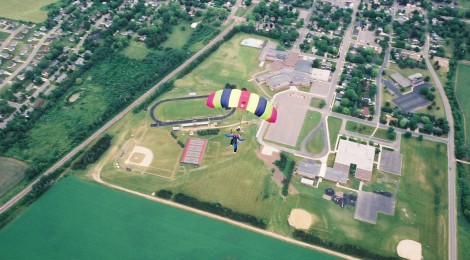
Accelerated Free Fall (AFF) Part 1: First Jump Ground Training
What made me or you skydive in the first place? Well, like many others, I had always wanted to skydive since college — it’s a dream of jumping off the airplane, experiencing the freedom of free-fall, and lingering around in the air at fast speed without limit.
Skydiving is a sport where gravity is your fun, the sky and ground are your limit. The fact is there is only you and the sky united in the air with no other object boundaries in between — it’s the biggest freedom a human can experience. Skydiving gives you physical and mental freedom, and the adrenalin rush you can’t have anywhere else on earth.
On June 11, 2006, my day started with six hours of AFF Category A First Jump ground training at Skydive Twin Cities in Baldwin, Wisconsin. The training covered two main topics, the primary and alternative flows of skydiving. The primary flow incorporated the detailed procedures of how to exit the aircraft, free-fall from 13,000 feet above the ground, deploy your parachute, fly the parachute and land safely. They are pretty much steps that should go according to your will. We called it best case scenario.
The alternative flow involved the procedures of how to handle parachute malfunction. Even though the alternative stream was not what we hoped for to happen, we were told many times to take it seriously. The instructor emphasized that malfunction happened and it could happen to anyone, as it just occurred to her last week on her jump. Fortunately, she was able to stabilize her parachute and landed safely on the ground.
We practiced malfunction procedures multiple times to remember well the steps needed to be taken in case it occurred during deployment, for example tangled string, canopy’s end cells closed, broken brake, slider half way down, etc. All of the training took place on the ground. There was no simulation practice. You had to remember and react upon it quickly and calmly in the air when malfunction happened. Do your best and hope for the best. And, maybe pray for your luck!
The good news is each skydiver is equipped with a reserved parachute in their pack, and your reserved is packed by a licensed parachute rigger/packer to ensure success during deployment. However, before you can deploy your reserved, you need to cut off your main canopy. The lost canopy will cost you approximately $1,500; the facility will certainly charge you for the loses if you are renting from them. But, can it buy you a life? Hell, yeah!
Six hours of ground training was soon completed. We waited for the afternoon wind to die down a bit. Six jumpers, eight instructors, and one videographer were squeezing in to fit into a small airplane. It flew us up to approximately 13,000 feet AGL (Above Ground Level). Once it reached that altitude, the airplane roamed around in a loop, we evacuated one student at a time with one or two other jump-masters for those who were still in training to go solo.
So, what it’s like after I jumped from the airplane? Click here to find out!


